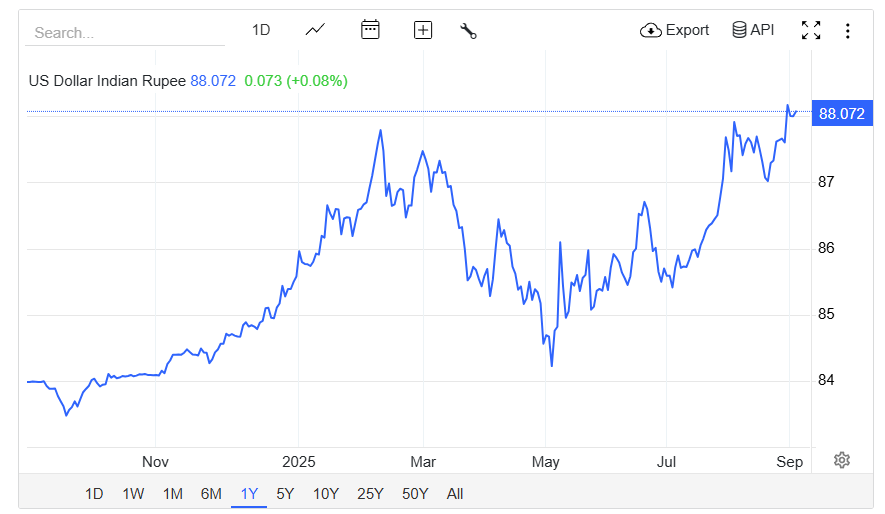The Indian rupee (INR) recently hit an all-time low of ₹88 against the US dollar (USD). That’s weaker than around ₹84 for $1 just a year ago. Basically, this is like your favourite chocolate bar that cost ₹10 last year now costing ₹15. You need more money to buy the same thing.

Rupee hits an all-time low against the Dollar
Trade Deficit pressure
One of the biggest reasons is India’s trade deficit, which is the gap between imports and exports. India buys more from other countries than it sells to them. We import large amounts of oil, gold, electronics, and machinery, but don’t export enough to balance it out. To pay for these imports, India needs more dollars than it earns, which makes the dollar more expensive.
50% US tariff on Indian goods
The situation has been made worse by the United States imposing a 50% tariff on Indian goods. India’s annual exports to the US stand at around $80 billion, of which nearly 70% or about $55 billion worth of sales are likely to be affected. That could mean India earns fewer dollars from the US, pushing up the demand for dollars even further.
Foreign investors pulling out
Another major factor is that large investment companies from abroad, known as Foreign Institutional Investors (FIIs), have been selling Indian stocks and taking their money back home. They believe Indian stocks are overvalued compared with other markets. When these investors convert rupees back into dollars, dollar demand rises and the rupee weakens further.
What this means for you
If you live in India, it could mean higher prices for products such as petrol, diesel, and electronics. For example, if you’re planning to buy a TV, the manufacturer may be importing some components from abroad.A weaker rupee means they now have to pay more for these imports, making your TV costlier. It also makes products of some Indian exporters more expensive compared with their peers in global markets.
Globe trotting becomes costlier
If you are a traveller, a weaker rupee could make foreign trips costlier. For instance, booking a hotel room that costs $100 a night would have cost you around ₹8,400 last year. This year, at the same dollar price, it will cost you ₹8,800.
Pay more for studying abroad
Students abroad are also hit. The rupee now gives fewer bangs for the buck, which means tuition fees, flights, and everyday expenses all become more expensive.
The positives of a weaker Rupee
It’s not all bad news. A weaker rupee makes Indian products cheaper in the global market, especially when no foreign components are involved. Why? Because $1 now buys goods worth ₹88 compared with ₹84 last year. That makes our exports more competitive.
Companies like TCS, Infosys, and Wipro, which earn a lot abroad in dollars, also benefit. When they bring those dollars back, they receive more in rupee terms. The same goes for many NRIs. For example, if an NRI sent $1,000 to India last year, the recipient would have got ₹84,000. This year, the same amount fetches ₹88,000.Tourism in India also benefits, as foreign tourists can potentially buy more for each dollar they spend compared with 2024.
A double-edged sword
However, overall the negatives outweigh the positives. Some experts call this a double-edged sword, mostly sharp on the wrong side. They argue that the impact is cutting ordinary Indians more than it is helping.






